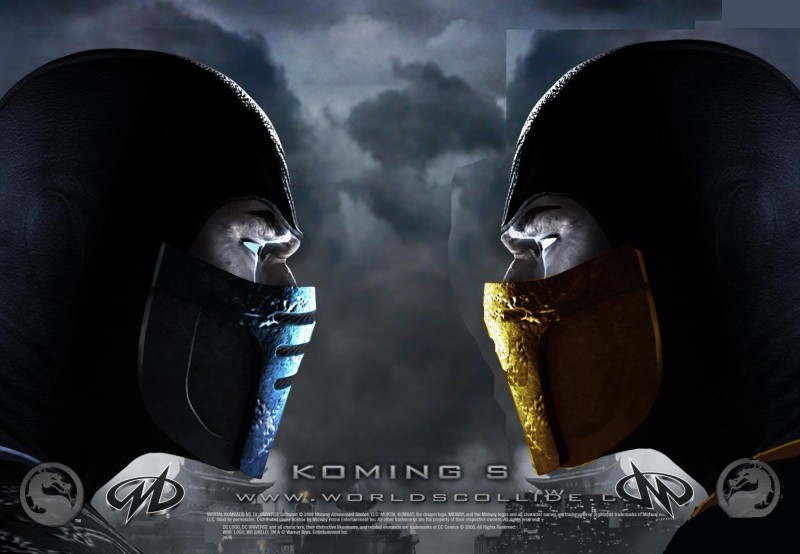The 2021 film contradicted or used creative liberties when compared to the approximate 30-year history of the Mortal Kombat franchise, but it still had a mildly favorable experience than Mortal Kombat: Annihilation. Although their fight was set in feudal Japan (the 1600s), the film used the canon set by the original and current video games’ timelines: Sub-Zero/Bi-Han killed Hanzo Hasashi. However, this film had Bi-Han murder Hanzo’s Shirai Ryu clan, wife, and son instead of Quan Chi. Also straying from canon involved the inclusion of Hanzo’s daughter, whose descendant was Cole Young. While Hanzo/Scorpion remained in the Netherrealm for over 400 years, he only learned how to say, “Get over here!” in English. The rest of Hanzo’s speech was in Japanese, but there was no indication that Cole was fluent in his ancestor’s native language. In addition, the video games showed that Cryomancers still age (e.g., Kuai Liang’s Sub-Zero in Mortal Kombat: Deadly Alliance and Mortal Kombat X), yet there was no explanation as to how Bi-Han appeared unaged for centuries. If the video games used the same history as the 1995 film and the television series, Mortal Kombat Conquest, only the tournament’s champion did not age; Goro would be the ageless victor.
One of the worst character depictions in the film included Goro. The nine-time champion (of at least 450 years) was reduced to a dishonorable lackey who did not show any superpowers and apparently never faced an opponent with weapons. The one who dispatched Goro, Cole Young, required help to defeat two other opponents (i.e., Mileena and Sub-Zero). While Shang Tsung insinuated that the deceased fighters might make a return, a film that would focus on rematches during the tournament would cheapen this film’s events. Some characters could return but should not necessarily participate in the tournament. Since Shao Kahn revived Mileena and healed a mortally wounded Goro in the original timeline, both characters could be featured again. If Goro returns to fight in the tournament, hopefully the character is done justice. Otherwise, Kintaro could take Goro’s place instead.
Quan Chi could resurrect Bi-Han and Kung Lao as the wraith Noob Saibot and a revenant, respectively. Liu Kang’s incentive to defeat Shang Tsung in the tournament could involve re-ensouling his fallen cousin. Unlike Mortal Kombat Legends: Scorpion’s Revenge, Liu must fight and defeat Shang (like he did in the original and current video games’ timelines, as well as in the 1995 film) instead of winning by concession (i.e., Scorpion taking Shang’s place and forfeiting). Since Reiko and Nitara were lesser-developed game characters, their resurrections would not be necessary. Kano could receive cybernetic implants and become Shao Kahn’s weapons general if he does return.
More elements of the film contradicted its own and the video games’ canon. First, fighters were not chosen due to a certain tattoo (from birth or bequeathed by a dead opponent) nor did their superpowers come from an awakened “arcana” in the games. If Johnny Cage appears in the next film, he should be born with the mark since his superpowers in the games followed his lineage. Second, Raiden stated that he could not interfere with the events of the actual tournament, but sparingly acted in events prior to the tournament: Raiden abducted Hanzo’s daughter, temporarily created a forcefield in the temple, teleported the Earthrealm fighters into the void and to fight the Outworld warriors, and attacked Shang Tsung after Bi-Han died (instead of stopping Shang from devouring Kung Lao’s soul). In the 1995 film, Raiden intervened twice before the tournament: He incapacitated Scorpion and Sub-Zero on the boat and stopped the Outworld minions from further attacking Liu Kang, Sonya, and Johnny Cage in Shang Tsung’s palace. Third, Bi-Han somehow did not age for centuries; Kuai Liang would have to be introduced as the ageless younger brother or a descendant of Bi-Han. Perhaps Kuai could fight Noob Saibot in the next film. Fourth, the inception of Jax’s cybernetic arms varied between the video games and the films. In the original timeline and in Mortal Kombat: Annihilation, the cybernetic arms were fitted over Jax’s real ones; his alternate costume in Mortal Kombat: Deadly Alliance showed that his regular arms still existed. However, Jax’s bionic arms became a necessary replacement following varied events since the ninth game: Ermac telekinetically severed them in Mortal Kombat (2011 game), shrapnel severely injured them in the first season of Mortal Kombat: Legacy, Goro tore them in Mortal Kombat Legends: Scorpion’s Revenge, and Sub-Zero shattered them in this film. Lastly, Sonya and Jax knew about the Mortal Kombat history and started the Outerworld Investigation Agency prior to Sonya competing in the tournament; they founded the agency after Sonya’s rescue between the events of the second and third games.
Although flawed, the film left desire for the introduction of more video game characters and stories to be translated into future films. Kitana and Johnny Cage should be featured in the next film because Mileena was introduced (rather than the sister from who she was partially cloned), and Johnny had competed in the first tournament. Quan Chi’s involvement with resurrecting characters like Hanzo and Bi-Han makes him a highly possible candidate for the next film. If Shao Kahn is featured, he must be menacing like the versions from the video games and in Mortal Kombat Conquest. More areas of the realms, such as Shao Kahn’s castle, could occur as well. The 1995 film may have been more faithful to the games, but this film showed more promise for the film franchise than Mortal Kombat: Annihilation.

















